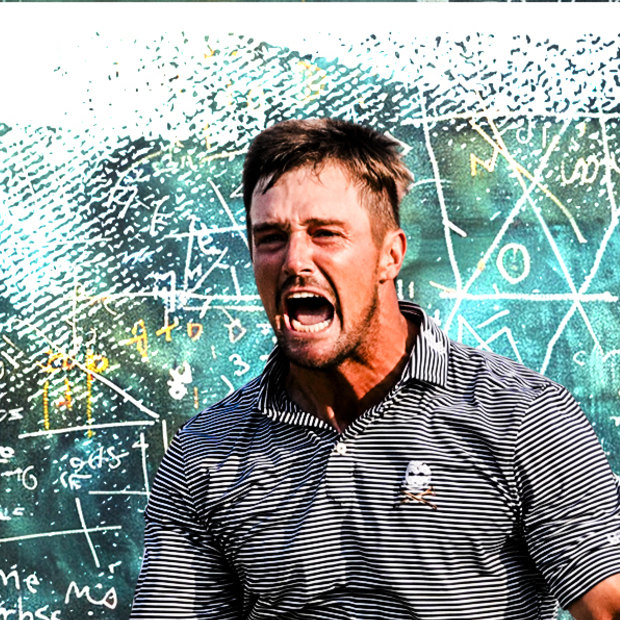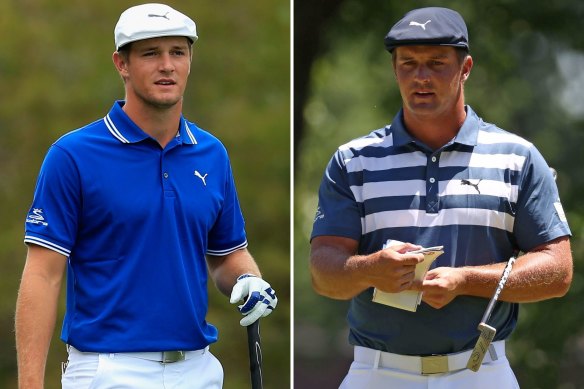This was published 10 months ago
3D-printed clubs and salty balls: Will golf’s Mad Scientist change the game?
Bryson DeChambeau is an eccentric golfer who uses his career like one big science experiment. And after winning another US Open, it’s working.
By Iain Payten

Bryson DeChambeau is golf’s version of a Beautiful Mind.Credit: Getty/Jamie Brown
How the US Open was lost became the story and understandably so. Rory McIlroy was distraught after a three-foot putt snaked by the cup on the 18th hole at Pinehurst No.2. He’d lost another major and gained a new nightmare.
Setting aside the drama, though, how the US Open was won was arguably more captivating, and may even end up changing the way golf is played.
Bryson DeChambeau claimed his second major on Monday (AEST), and it was a victory for science.
DeChambeau, 30, is known as the “Mad Scientist” because of his eccentric approach to playing golf, and the unique tools, techniques and tactics he employs to try to chase perfection.
In a sport where cruel whims of the golfing gods have always been accepted as part of the deal, DeChambeau decided he would not and set out to pull golf apart scientifically to mistake-proof his game.
“That’s been my biggest thing in life,” DeChambeau said in a 2021 interview. “Trying to reduce variables.”
Since DeChambeau emerged in 2015 as a star college golfer, where the former maths prodigy majored in physics, the youngster began trying to make his golf swing like a science experiment: repeatable.

Bryson DeChambeau celebrates after winning the U.S. Open golf tournament.Credit: AP
DeChambeau began using (and still uses) single-length irons, meaning all the irons and traditionally shorter wedges in his bag are the same length as his 7-iron. It allows him to use the same swing for almost every shot, and he also uses a single-plane swing, with no wrist bending, to further standardise.
Unlike most pros, DeChambeau also uses extremely thick grips on his clubs.
When he made the PGA Tour, DeChambeau began trying the rare side-saddle putting technique, where a golfer faces the hole and putts away from the body.

Bryson DeChambeau using the “side saddle” technique in 2017.Credit: US PGA TOUR
In the first of many skirmishes with golf authorities, DeChambeau’s long putter was deemed illegal and he abandoned the method. But having also studied biomechanics and the natural benefits of end-range of motion, he switched to an awkward-looking locked-arm style that he still uses.
It was just the beginning. Where most athletes are scared stiff of doing something drastically new mid-career, DeChambeau has used his career so far as one big experiment.
Using electrodes stuck to his head and a nightly scary movie, in 2018 he began using neurology technology to train his brain to deal with stress better.
DeChambeau also famously began floating his golf balls in Epsom salts to identify which ones did not have weight exactly centred. He marks the “heavy end” on each to ensure putts roll evenly.

Bryson DeChambeau celebrates with fans after winning the US Open.Credit: Getty Images
“What I’m doing is finding pretty much the out-of-balanceness of it ... it’s just because of the manufacturing process,” DeChambeau said last week at the US Open. “There’s always going to be an error, especially when it’s a sphere and there’s dimples on the edges. You can’t perfectly get it in the centre.”
DeChambeau’s eye for detail sees him study all elements of a golf course intensely, down to sand and grass type and even barometric pressure, so when calculating distance and club choice, errors are minimised. The Californian was even banned from using a protractor in his course book while playing.
After getting last-minute approval, DeChambeau played at the Masters this year using 3D-printed irons and helped design a bespoke set with “bulge and roll” on the faces, normally only found on drivers. His driver? DeChambeau uses a brand only regularly used by long-driving competitors, because he found the club more durable.
Perhaps the most famous experiment of DeChambeau, however, is when he decided he needed to add distance to his game, and began bulking up. Smashing 6000 calories and the weight room every day, DeChambeau put on over 20 kilograms, and he comfortably led the PGA Tour for club head and ball speed, and distance too. In 2021, he recorded a staggering ball speed of 335km/h.
A bulked-up DeChambeau won his first US Open at Winged Foot in 2020 and rivals also began hitting the protein shakes to keep up. A few years on DeChambeau trimmed down again on a better balanced diet, but most of his distance remains.

Bryson DeChambeau in 2016 (left), and in 2020 (right) after he packed on 25 kilograms.Credit: Getty
Known for his work ethic, DeChambeau’s practice regimen is hi-tech. Everything on the range is filmed and run through computer programs to focus almost entirely on picking up, and fixing, swing inconsistencies. Where the ball goes is almost secondary.
Just before his final round at Pinehurst No.2 on the warm-up range, a few errant results with his driver were spat out and DeChambeau swapped out the club head just before tee-off. That would scare the plus-fours off most professionals, but DeChambeau trusts the data implicitly.
“We see it in all sport, generations come along and change the sport and the way they want to do it,” former PGA Tour player and leading Australian commentator Paul Gow said.
“From Ben Hogan, to Jack Nicklaus to Greg Norman and Tiger Woods, they have their own push on the game in what they do. This guy has come along, and he has learned a lot from Tiger Woods. He changed the game in the way we train, the way we hit the ball, the way we swing … he turned it into an athletic sport.
“And Bryson, what he has done is turbocharge that. He is a mad scientist. He leaves no stone unturned.
‘He is prepared to train at extreme levels, and not worry about the potential negatives. Most golfers would be scared stiff of [injury].’
Former Australian golfer Paul Gow on Bryson DeChambeau
“Single-length shafts, I mean it makes sense. The science and the logic behind that makes sense. But we have been told from 300 years ago, the progressive [length] clubs are the go and we have been sold that. He goes: ‘Well, no, I am going to question that’.
“He has gone deep. He just hasn’t taken the word of the R&D guys, and the design guys of equipment and golf courses. The rest of us have been happy to, largely.
“You have to have that genius-type mentality to be able to do that. To be able to understand the how and why, to start with, and then ask the right questions.”
Gow once had a caddy friend ask DeChambeau what his goal was with the Hulk bulk-up, and the answer came back he wanted to push his body to breaking point, so then he could dial back to the highest possible, but safe, level.
“That spun me out,” Gow said. “He is prepared to train at extreme levels, and not worry about the potential negatives. Most golfers would be scared stiff of injuring backs or necks or whatever.”
He has 13 professional wins but for the most part, DeChambeau is still out on his own as far as his “wacky” ideas and practices.
But after collecting his second major, the question is: when will others start to copy the DeChambeau way? And why don’t they already?
“Results will do that. If he becomes a five-six-seven-time major champion, people will follow,” Gow said.
Regarded for a long time as a prickly and unlikeable player, DeChambeau’s decision to join the Saudi-backed LIV Tour in 2022, for a $187 million pay cheque, seemed to further fit the villain persona.
But the move has actually taken his public profile the other way. He is now one of the most prolific golfers on social media and has a popular YouTube channel with 700,000 subscribers, where DeChambeau posts quirky challenges and self-deprecating content.
Critics say it is also a finely calculated strategy from DeChambeau to rehabilitate his image, but there was no mistaking he was a fan favourite at the US Open. He spent hours at the course signing autographs and allowing everyone to hold the trophy.
Gow says the connections with a new audience is where a DeChambeau golf revolution may start.
“He is engaging with fans, he is bringing in new people, young people to the game,” he said.
“And they’re gonna be the ones. They will pick up a club and say ‘I want to hit it like the Mad Scientist’.”
Sports news, results and expert commentary. Sign up for our Sport newsletter.